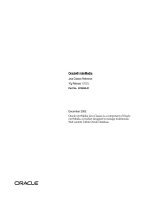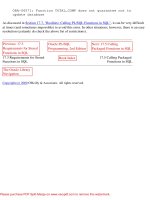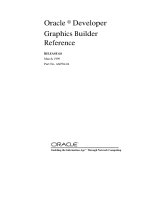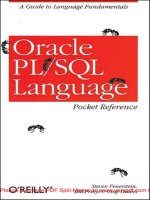Tài liệu Oracle PL/SQL Language Pocket Reference- P28 docx
Bạn đang xem bản rút gọn của tài liệu. Xem và tải ngay bản đầy đủ của tài liệu tại đây (171.54 KB, 50 trang )
The Oracle Library
Navigation
Copyright (c) 2000 O'Reilly & Associates. All rights reserved.
Please purchase PDF Split-Merge on www.verypdf.com to remove this watermark.
Previous: C.2
DBMS_ALERT
Appendix C
Built-In Packages
Next: C.4 DBMS_DDL
C.3 Oracle AQ, the Advanced Queueing Facility
Oracle8 offers the Oracle Advanced Queuing facility (Oracle AQ) which implements deferred
execution of work. There are two packages you will use to implement advanced queuing:
DBMS_AQ, which contains the queuing procedures themselves, and DBMS_AQADM, which lets
you perform administrative tasks. They make extensive use of PL/SQL record structures, as you will
see in the individual program interfaces below. For more detail on these records and how to
manipulate their contents, see Oracle Built-in Packages.
C.3.1 DBMS_AQ (PL/SQL 8 Only)
The DBMS_AQ package provides an interface to the messaging tasks of Oracle AQ. To use these
procedures, you must have been granted the new role, AQ_USER_ROLE.
C.3.1.1 The
ENQUEUE procedure
The ENQUEUE procedure adds a message to an existing message queue. The target message queue
must have had enqueuing enabled previously via the DBMS_ AQADM.START_QUEUE procedure.
The specification is:
PROCEDURE DBMS_AQ.ENQUEUE
(q_schema IN VARCHAR2 DEFAULT NULL
q_name IN VARCHAR2,
corrid IN VARCHAR2 DEFAULT NULL,
transactional IN BOOLEAN:= TRUE,
priority IN POSITIVE DEFAULT 1,
delay IN DATE DEFAULT NULL,
expiration IN NATURAL:= 0,
relative_msgid IN NUMBER DEFAULT NULL,
seq_deviation IN CHAR DEFAULT A,
exception_queue_schema IN VARCHAR2 DEFAULT NULL,
exception_queue IN VARCHAR2 DEFAULT NULL,
Please purchase PDF Split-Merge on www.verypdf.com to remove this watermark.
reply_queue_schema IN VARCHAR2 DEFAULT NULL,
reply_queue IN VARCHAR2 DEFAULT NULL,
user_data IN any_object_type,
msgid OUT RAW);
C.3.1.2 The
DEQUEUE procedure
The DEQUEUE procedure can either remove or browse a message from an existing message queue.
The target message queue must have had dequeuing enabled previously via the DBMS_AQADM.
STOP_QUEUE procedure. The specification is:
PROCEDURE DBMS_AQ.DEQUEUE
(q_schema IN VARCHAR2 DEFAULT NULL,
q_name IN VARCHAR2,
msgid IN RAW DEFAULT NULL,
corrid IN VARCHAR2 DEFAULT NULL,
deq_mode IN CHAR DEFAULT `D',
wait_time IN NATURAL DEFAULT NULL,
transactional IN BOOLEAN:= true,
out_msgid OUT NUMBER,
out_corrid OUT VARCHAR2,
priority OUT POSITIVE,
delay OUT DATE,
expiration OUT NATURAL,
retry OUT NATURAL,
exception_queue_schema OUT VARCHAR2,
exception_queue OUT VARCHAR2,
reply_queue_schema OUT VARCHAR2,
reply_queue OUT VARCHAR2,
user_data OUT any_object_type);
C.3.2 DBMS_AQADM (PL/SQL 8 Only)
The DBMS_AQADM package provides an interface to the administrative tasks of Oracle AQ. To use
these procedures, a DBMS_AQADM user must have been granted the new role,
AQ_ADMINISTRATOR_ROLE. You can verify the results of executing the DBMS_ AQADM
package by querying the new Oracle AQ data dictionary views, USER_QUEUE_ TABLES and
USER_QUEUES (DBA levels of these views are also available).
C.3.2.1 The
CREATE_QUEUE_TABLE procedure
Please purchase PDF Split-Merge on www.verypdf.com to remove this watermark.
The CREATE_QUEUE_TABLE procedure creates a queue table. A queue table is the named
repository for a set of queues and their messages. A queue table may contain numerous queues, each
of which may have many messages. But a given queue and its messages may exist in only one queue
table. The specification is:
PROCEDURE DBMS_AQADM.CREATE_QUEUE_TABLE
(queue_table IN VARCHAR2
,queue_payload_type IN VARCHAR2
,storage_clause IN VARCHAR2 DEFAULT NULL
,sort_list IN VARCHAR2 DEFAULT NULL
,multiple_consumers IN BOOLEAN DEFAULT FALSE
,message_grouping IN BINARY_INTEGER DEFAULT NONE
,comment IN VARCHAR2 DEFAULT NULL
,auto_commit IN BOOLEAN DEFAULT TRUE);
C.3.2.2 The
DROP_QUEUE_TABLE procedure
The DROP_QUEUE_TABLE procedure drops an existing queue table. An error is returned if the
queue table does not exist. The force parameter specifies whether all existing queues in the queue
table are stopped and dropped automatically or manually. If manually (i.e., FALSE), then the queue
administrator must stop and drop all existing queues within the queue table using the
DBMS_AQADM.STOP_QUEUE and DBMS_AQADM.DROP_QUEUE procedures. The
specification is:
PROCEDURE DBMS_AQADM.DROP_QUEUE_TABLE
(queue_table IN VARCHAR2,
force IN BOOLEAN default FALSE,
auto_commit IN BOOLEAN default TRUE);
C.3.2.3 The
CREATE_QUEUE procedure
The CREATE_QUEUE procedure creates a new message queue within an existing queue table. An
error is returned if the queue table does not exist. The required queue_name parameter specifies the
name of the new message queue to create. All queue names must be unique within the schema. The
specification is:
PROCEDURE DBMS_AQADM.CREATE_QUEUE
(queue_name IN VARCHAR2,
queue_table IN VARCHAR2,
queue_type IN BINARY_INTEGER default DBMS_AQADM.
Please purchase PDF Split-Merge on www.verypdf.com to remove this watermark.
NORMAL_QUEUE,
max_retries IN NUMBER default 0,
retry_delay IN NUMBER default 0,
retention_time IN NUMBER default 0,
dependency_tracking IN BOOLEAN default FALSE,
comment IN VARCHAR2 default NULL,
auto_commit IN BOOLEAN default TRUE);
C.3.2.4 The
ALTER_QUEUE procedure
The ALTER_QUEUE procedure modifies properties of an existing message queue. It returns an error
if the message queue does not exist. Currently, you can alter only the maximum retries, retry delay,
retention time, rentention delay and auto-commit properties; Oracle will augment this list in future
releases. The specification is:
PROCEDURE DBMS_AQADM.ALTER_QUEUE (
queue_name IN VARCHAR2,
max_retries IN NUMBER default NULL,
retry_delay IN NUMBER default NULL,
retention_time IN NUMBER default NULL,
auto_commit IN BOOLEAN default TRUE);
C.3.2.5 The
DROP_QUEUE procedure
The DROP_QUEUE procedure drops an existing message queue. It returns an error if the message
queue does not exist. DROP_QUEUE is not allowed unless STOP_QUEUE has been called to
disable both enqueuing and dequeuing for the message queue to be dropped. If the message queue has
not been stopped, then DROP_QUEUE returns an error of queue resource busy. The specification is:
PROCEDURE DBMS_AQADM.DROP_QUEUE_TABLE
(queue_table IN VARCHAR2,
force IN BOOLEAN default FALSE,
auto_commit IN BOOLEAN default TRUE);
C.3.2.6 The
START_QUEUE procedure
The START_QUEUE procedure enables an existing message queue for enqueuing and dequeuing. It
returns an error if the message queue does not exist. The default is to enable both. The specification
is:
Please purchase PDF Split-Merge on www.verypdf.com to remove this watermark.
PROCEDURE DBMS_AQADM.START_QUEUE (
queue_name IN VARCHAR2,
enqueue IN BOOLEAN DEFAULT TRUE,
dequeue IN BOOLEAN DEFAULT TRUE);
C.3.2.7 The
STOP_QUEUE procedure
The STOP_QUEUE procedure disables an existing message queue for enqueuing and dequeuing. It
returns an error if the message queue does not exist. The default is to disable both enqueuing and
dequeuing. The wait parameter specifies whether to wait for outstanding transactions or to return
immediately. The wait option is highly dependent on outstanding transactions. If outstanding
transactions exist, then wait will either hang until the transactions complete or return an error of ORA-
24203, depending on whether the wait parameter is set to true or false. The specification is:
PROCEDURE DBMS_AQADM.STOP_QUEUE
(queue_name IN VARCHAR2,
enqueue IN BOOLEAN DEFAULT TRUE,
dequeue IN BOOLEAN DEFAULT TRUE,
wait IN BOOLEAN DEFAULT TRUE);
Previous: C.2
DBMS_ALERT
Oracle PL/SQL
Programming, 2nd Edition
Next: C.4 DBMS_DDL
C.2 DBMS_ALERT
Book Index
C.4 DBMS_DDL
The Oracle Library
Navigation
Copyright (c) 2000 O'Reilly & Associates. All rights reserved.
Please purchase PDF Split-Merge on www.verypdf.com to remove this watermark.
Previous: C.3 Oracle AQ,
the Advanced Queueing
Facility
Appendix C
Built-In Packages
Next: C.5 DBMS_ JOB
C.4 DBMS_DDL
The DBMS_DDL package provides access to some of the SQL DDL statements from within stored
procedures.
C.4.1 The ALTER_COMPILE procedure
The ALTER_COMPILE procedure can be used to programmatically force a recompile of a stored
object. The specification is:
PROCEDURE DBMS_DDL.ALTER_COMPILE
(type VARCHAR2,
schema VARCHAR2,
name VARCHAR2);
C.4.2 The ANALYZE_OBJECT procedure
A call to ANALYZE_OBJECT lets you programmatically compute statistics for the specified object.
The specification is:
PROCEDURE DBMS_DDL.ANALYZE_OBJECT
(type VARCHAR2,
schema VARCHAR2,
name VARCHAR2,
method VARCHAR2,
estimate_rows NUMBER DEFAULT NULL,
estimate_percent NUMBER DEFAULT NULL);
Previous: C.3 Oracle AQ,
the Advanced Queueing
Facility
Oracle PL/SQL
Programming, 2nd Edition
Next: C.5 DBMS_ JOB
Please purchase PDF Split-Merge on www.verypdf.com to remove this watermark.
C.3 Oracle AQ, the
Advanced Queueing Facility
Book Index
C.5 DBMS_ JOB
The Oracle Library
Navigation
Copyright (c) 2000 O'Reilly & Associates. All rights reserved.
Please purchase PDF Split-Merge on www.verypdf.com to remove this watermark.
Previous: C.4 DBMS_DDL
Appendix C
Built-In Packages
Next: C.6 DBMS_LOB
(PL/SQL8 Only)
C.5 DBMS_ JOB
The DBMS_ JOB package provides a way for you to schedule jobs from within the Oracle RDBMS.
A job is a call to a single stored procedure. You can submit a job to run once or on a recurring basis.
Once a job has been submitted, you can check on the status of the job by viewing a data dictionary
table. You can also change the parameters of the job with the CHANGE procedure. When you submit
a job, you must provide a string that describes that job to the DBMS_ JOB package and specify a job
execution interval.
C.5.1 The BROKEN procedure
The Oracle Server considers a job to be broken if it has tried and failed 16 times to run the job. At
this point, Oracle marks the job as broken and will no longer try to run the job until either (a) you
mark the job as fixed or (b) you force the job to execute with a call to the RUN procedure. Use the
BROKEN procedure to mark the job as fixed and specify the next date on which you want the job to
run. The specification is:
PROCEDURE DBMS_JOB.BROKEN
(job IN BINARY_INTEGER,
broken IN BOOLEAN,
next_date IN DATE DEFAULT SYSDATE);
C.5.2 The CHANGE procedure
Use the CHANGE procedure to change one or all of the attributes of a job. The specification is:
PROCEDURE DBMS_JOB.CHANGE
(job IN BINARY_INTEGER,
what IN VARCHAR2,
next_date IN DATE,
interval IN VARCHAR2);
C.5.3 The INTERVAL procedure
Please purchase PDF Split-Merge on www.verypdf.com to remove this watermark.
Use the INTERVAL procedure to change the interval for which a queued job is going to run. The
specification is:
PROCEDURE DBMS_JOB.INTERVAL
(job IN BINARY_INTEGER,
interval IN VARCHAR2);
C.5.4 The ISUBMIT procedure
The ISUBMIT procedure submits a new job with a specified job number to the queue. The difference
between ISUBMIT and SUBMIT (described later in this section) is that ISUBMIT specifies a job
number, whereas SUBMIT returns a job number generated by the DBMS_JOB package. The
specification is:
PROCEDURE DBMS_JOB.ISUBMIT
(job IN BINARY_INTEGER,
what IN VARCHAR2,
next_date in DATE DEFAULT SYSDATE
interval IN VARCHAR2 DEFAULT 'NULL',
no_parse in BOOLEAN DEFAULT FALSE);
C.5.5 The NEXT_DATE procedure
Use the NEXT_DATE procedure to change when a queued job is going to run. The specification is:
PROCEDURE DBMS_JOB.NEXT_DATE
(job IN BINARY_INTEGER,
next_date IN DATE);
C.5.6 The REMOVE procedure
Use the REMOVE procedure to remove a job from the queue. If the job has started execution, you
cannot remove it from the queue. The specification is:
PROCEDURE DBMS_JOB.REMOVE (job IN BINARY_INTEGER);
C.5.7 The RUN procedure
Use the RUN procedure to force a job to be executed immediately, regardless of the values for
next_date and interval stored in the job queue. The specification is:
PROCEDURE DBMS_JOB.RUN (job IN BINARY_INTEGER);
Please purchase PDF Split-Merge on www.verypdf.com to remove this watermark.
C.5.8 The SUBMIT procedure
The SUBMIT procedure submits jobs to the queue. The specification is:
PROCEDURE DBMS_JOB.SUBMIT
(job OUT BINARY_INTEGER,
what IN VARCHAR2,
next_date IN DATE DEFAULT SYSDATE,
interval IN VARCHAR2 DEFAULT 'NULL',
no_parse IN BOOLEAN DEFAULT FALSE);
C.5.9 The USER_EXPORT procedure
The USER_EXPORT procedure is used to extract the job string from a job in the queue. The
specification is:
PROCEDURE DBMS_JOB.USER_EXPORT
(job IN BINARY_INTEGER,
mycall OUT VARCHAR2);
C.5.10 The WHAT procedure
Use the WHAT procedure to change what a queued job is going to run. The specification is:
PROCEDURE DBMS_JOB.WHAT
(job IN BINARY_INTEGER,
what IN VARCHAR2);
Previous: C.4 DBMS_DDL
Oracle PL/SQL
Programming, 2nd Edition
Next: C.6 DBMS_LOB
(PL/SQL8 Only)
C.4 DBMS_DDL
Book Index
C.6 DBMS_LOB (PL/SQL8
Only)
The Oracle Library
Navigation
Copyright (c) 2000 O'Reilly & Associates. All rights reserved.
Please purchase PDF Split-Merge on www.verypdf.com to remove this watermark.
Previous: C.5 DBMS_ JOB
Appendix C
Built-In Packages
Next: C.7 DBMS_LOCK
C.6 DBMS_LOB (PL/SQL8 Only)
Use the DBMS_LOB package to manipulate LOBs (large objects) from within a PL/SQL program
and SQL statements. With DBMS_LOB you can read and modify BLOBs (binary LOBs), CLOBs
(single-byte character data), and NCLOBs (fixed-width single-byte or multibyte character data), and
you can perform read-only operations on BFILEs (file-based LOBs).
C.6.1 The
APPEND procedure
Call the APPEND procedure to append the contents of a source LOB to a destination LOB. The
specifications are:
PROCEDURE DBMS_LOB.APPEND
(dest_lob IN OUT BLOB,
src_lob IN BLOB);
PROCEDURE DBMS_LOB.APPEND
(dest_lob IN OUT CLOB CHARACTER SET ANY_CS,
src_lob IN CLOB CHARACTER SET DEST_LOB%CHARSET);
C.6.2 The
COMPARE function
Use the compare function to compare two LOBs in their entirety, or compare just parts of two LOBs.
The specifications are:
FUNCTION DBMS_LOB.COMPARE
(lob_1 IN BLOB,
lob_2 IN BLOB,
amount IN INTEGER := 4294967295,
Please purchase PDF Split-Merge on www.verypdf.com to remove this watermark.
offset_1 IN INTEGER := 1,
offset_2 IN INTEGER := 1)
RETURN INTEGER;
FUNCTION DBMS_LOB.COMPARE
(lob_1 IN CLOB CHARACTER SET ANY_CS,
lob_2 IN CLOB CHARACTER SET LOB_1%CHARSET,
amount IN INTEGER := 4294967295,
offset_1 IN INTEGER := 1,
offset_2 IN INTEGER := 1)
RETURN INTEGER;
FUNCTION DBMS_LOB.COMPARE
(file_1 IN BFILE,
file_2 IN BFILE,
amount IN INTEGER,
offset_1 IN INTEGER := 1,
offset_2 IN INTEGER := 1)
RETURN INTEGER;
C.6.3 The
COPY procedure
The copy procedure copies all or part of a source LOB to a destination LOB. The specifications are:
PROCEDURE DBMS_LOB.COPY
(dest_lob IN OUT BLOB,
src_lob IN BLOB,
amount IN OUT INTEGER,
dest_offset IN INTEGER := 1,
src_offset IN INTEGER := 1);
PROCEDURE DBMS_LOB.COPY
(dest_lob IN OUT CLOB CHARACTER SET ANY_CS,
src_lob IN CLOB CHARACTER SET DEST_LOB%CHARSET,
amount IN OUT INTEGER,
dest_offset IN INTEGER := 1,
src_offset IN INTEGER := 1);
C.6.4 The
ERASE procedure
The erase procedure erases an entire LOB or part of a LOB. The specifications are:
Please purchase PDF Split-Merge on www.verypdf.com to remove this watermark.
PROCEDURE DBMS_LOB.ERASE
(lob_loc IN OUT BLOB,
amount IN OUT INTEGER,
offset IN INTEGER := 1);
PROCEDURE DBMS_LOB.ERASE
(lob_loc IN OUT CLOB CHARACTER SET ANY_CS,
amount IN OUT INTEGER,
offset IN INTEGER := 1);
C.6.5 The
FILECLOSE procedure
Call the fileclose procedure to close a BFILE which has previously been opened in your session or
PL/SQL block. The specification is:
PROCEDURE DBMS_LOB.FILECLOSE (file_loc IN OUT BFILE);
C.6.6 The
FILECLOSEALL procedure
The filecloseall procedure closes all BFILEs which have previously been opened in your session. The
specification is:
PROCEDURE DBMS_LOB.FILECLOSEALL;
C.6.7 The
FILEEXISTS function
The fileexists function returns 1 if the file you have specified via a BFILE locator exists. The
specification is:
FUNCTION DBMS_LOB.FILEEXISTS (file_loc IN BFILE) RETURN
INTEGER;
C.6.8 The
FILEGETNAME procedure
Please purchase PDF Split-Merge on www.verypdf.com to remove this watermark.
Use the filegetname procedure to translate a BFILE locator into its directory alias and filename
components. The specification is:
PROCEDURE DBMS_LOB.FILEGETNAME
(file_loc IN BFILE,
dir_alias OUT VARCHAR2,
filename OUT VARCHAR2);
C.6.9 The
FILEISOPEN function
The fileisopen function returns 1 if the BFILE is already open. The specification is:
FUNCTION DBMS_LOB.FILEISOPEN (file_loc IN BFILE) RETURN
INTEGER;
C.6.10 The
FILEOPEN procedure
The fileopen procedure opens a BFILE with the specified mode. The specification is:
PROCEDURE DBMS_LOB.FILEOPEN
(file_loc IN OUT BFILE,
open_mode IN BINARY_INTEGER := FILE_READONLY);
C.6.11 The
GETLENGTH function
Use the getlength function to return the length of the specified LOB in bytes or characters, depending
on the type of LOB. The specifications are:
FUNCTION DBMS_LOB.GETLENGTH (lob_loc IN BLOB) RETURN
INTEGER;
FUNCTION DBMS_LOB.GETLENGTH(lob_loc IN CLOB CHARACTER SET
ANY_CS)
RETURN INTEGER;
FUNCTION DBMS_LOB.GETLENGTH (file_loc IN BFILE) RETURN
INTEGER;
Please purchase PDF Split-Merge on www.verypdf.com to remove this watermark.
C.6.12 The
INSTR function
The instr function returns the matching location of the nth occurrence of the specified pattern in the
LOB. The specifications are:
FUNCTION DBMS_LOB.INSTR
(lob_loc IN BLOB,
pattern IN RAW,
offset IN INTEGER := 1,
nth IN INTEGER := 1)
RETURN INTEGER;
FUNCTION DBMS_LOB.INSTR
(lob_loc IN CLOB CHARACTER SET ANY_CS,
pattern IN VARCHAR2 CHARACTER SET LOB_LOC%CHARSET,
offset IN INTEGER := 1,
nth IN INTEGER := 1)
RETURN INTEGER;
FUNCTION DBMS_LOB.INSTR
(file_loc IN BFILE,
pattern IN RAW,
offset IN INTEGER := 1,
nth IN INTEGER := 1)
RETURN INTEGER;
C.6.13 The
READ procedure
Call the read procedure to read a portion of a LOB into a buffer variable. The specifications are:
PROCEDURE DBMS_LOB.READ
(lob_loc IN BLOB,
amount IN OUT BINARY_INTEGER,
offset IN INTEGER,
buffer OUT RAW);
PROCEDURE DBMS_LOB.READ
(lob_loc IN CLOB CHARACTER SET ANY_CS,
amount IN OUT BINARY_INTEGER,
offset IN INTEGER,
Please purchase PDF Split-Merge on www.verypdf.com to remove this watermark.
buffer OUT VARCHAR2 CHARACTER SET LOB_LOC%CHARSET);
PROCEDURE DBMS_LOB.READ
(file_loc IN BFILE,
amount IN OUT BINARY_INTEGER,
offset IN INTEGER,
buffer OUT RAW);
C.6.14 The
SUBSTR function
The substr function returns the specified number of bytes or characters from a LOB. The
specifications are:
FUNCTION DBMS_LOB.SUBSTR
(lob_loc IN BLOB,
amount IN INTEGER := 32767,
offset IN INTEGER := 1)
RETURN RAW;
FUNCTION DBMS_LOB.SUBSTR
(lob_loc IN CLOB CHARACTER SET ANY_CS,
amount IN INTEGER := 32767,
offset IN INTEGER := 1)
RETURN VARCHAR2;
FUNCTION DBMS_LOB.SUBSTR
(file_loc IN BFILE,
amount IN INTEGER := 32767,
offset IN INTEGER := 1)
RETURN RAW;
C.6.15 The
TRIM procedure
Use the trim procedure to trim the LOB value to the length you specify. The specifications are:
PROCEDURE DBMS_LOB.TRIM
(lob_loc IN OUT BLOB,
newlen IN INTEGER);
PROCEDURE DBMS_LOB.TRIM
Please purchase PDF Split-Merge on www.verypdf.com to remove this watermark.
(lob_loc IN OUT CLOB CHARACTER SET ANY_CS,
newlen IN INTEGER);
C.6.16 The
WRITE procedure
Call the write procedure to write a specified number of bytes or characters from a buffer variable into
a LOB at a specified position. The specifications are:
PROCEDURE DBMS_LOB.WRITE
(lob_loc IN OUT BLOB,
amount IN OUT BINARY_INTEGER,
offset IN INTEGER,
buffer IN RAW);
PROCEDURE DBMS_LOB.WRITE
(lob_loc IN OUT CLOB CHARACTER SET ANY_CS,
amount IN OUT BINARY_INTEGER,
offset IN INTEGER,
buffer IN VARCHAR2 CHARACTER SET LOB_LOC%CHARSET);
Previous: C.5 DBMS_ JOB Oracle PL/SQL
Programming, 2nd Edition
Next: C.7 DBMS_LOCK
C.5 DBMS_ JOB
Book Index
C.7 DBMS_LOCK
The Oracle Library
Navigation
Copyright (c) 2000 O'Reilly & Associates. All rights reserved.
Please purchase PDF Split-Merge on www.verypdf.com to remove this watermark.
Previous: C.6 DBMS_LOB
(PL/SQL8 Only)
Appendix C
Built-In Packages
Next: C.8 DBMS_MAIL
C.7 DBMS_LOCK
The DBMS_LOCK package provides you with access to the Oracle Lock Management (OLM)
services. With OLM, you can request a lock of a particular type, assign it a name that can then be
used as a handle to this lock, modify the lock, and even release the lock. A lock you create with the
DBMS_LOCK package has all the functionality of a lock generated by the Oracle RDBMS, including
deadlock detection and view access through SQL*DBA and the relevant virtual tables.
C.7.1 The ALLOCATE_UNIQUE procedure
The ALLOCATE_UNIQUE procedure allocates a unique lock handle for the specified lock name.
The specification is:
PROCEDURE DBMS_LOCK.ALLOCATE_UNIQUE
(lockname IN VARCHAR2,
lockhandle OUT VARCHAR2,
expiration_secs IN INTEGER DEFAULT 864000);
C.7.2 The CONVERT function
The CONVERT function converts a lock from one type or mode to another. The specifications are:
FUNCTION DBMS_LOCK.CONVERT
(id IN INTEGER,
lockmode IN INTEGER,
timeout IN NUMBER DEFAULT MAXWAIT)
RETURN INTEGER;
FUNCTION DBMS_LOCK.CONVERT
(lockhandle IN VARCHAR2,
lockmode IN INTEGER,
timeout IN NUMBER DEFAULT MAXWAIT)
RETURN INTEGER;
Please purchase PDF Split-Merge on www.verypdf.com to remove this watermark.
The function returns the status of the attempt to change the mode, as shown below:
0
Success.
1
Timeout. The lock could not be converted within the specified number of seconds.
2
Deadlock. In this case, an arbitrary session will be rolled back.
3
Parameter error.
4
The session does not own the lock specified by lock ID or the lock handle.
5
Invalid lock handle. The handle was not found on the DBMS_LOCK_ALLOCATED table.
C.7.3 The RELEASE function
The RELEASE function releases the specified lock. This specifications are:
FUNCTION DBMS_LOCK.RELEASE (id IN INTEGER) RETURN INTEGER;
FUNCTION DBMS_LOCK.RELEASE (lockhandle IN VARCHAR2)
RETURN INTEGER;
In both cases, the RELEASE function returns a status with one of four values:
0
Successful release of lock
3
Error in the parameter passed to release
4
Session does not own lock specified by ID or lock handle
5
Illegal lock handle
Please purchase PDF Split-Merge on www.verypdf.com to remove this watermark.









